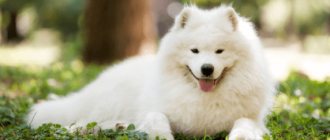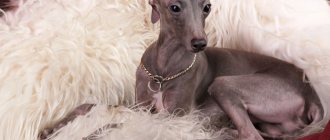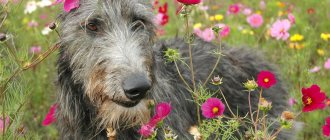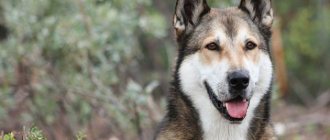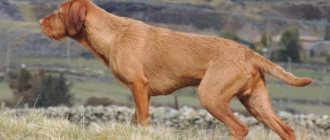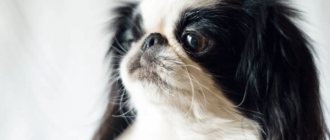History of the pit bull breed
Pit bull with cropped ears
The word “American” in the name of the breed gives the erroneous impression that the birthplace of the pit bull terrier is the United States. In fact, the first pit bulls came to the Western Hemisphere from Britain. Their appearance was the result of crossing the Old English Terrier and the Old English Bulldog. The breeders of that time set themselves the task of combining the speed, fearlessness and strength of the former and the athleticism of the latter in the “new” dog. As you can see, they did it very well.
In Foggy Albion, pit bulls were used in dog fights and set against bears and bulls. In 1835, when animal protection laws began to appear, these four-legged fighters were no longer pitted against bulls and bears. Since dog fighting was not directly prohibited by law (besides, they were cheaper), the breed de facto remained widely involved in them. Animal advocates considered such competitions frankly “barbaric”, a mockery of our smaller brothers. However, one cannot help but admit the fact that, in addition to a good income for the organizers, these fights also gave a lot to the breed itself, identifying its best representatives. The practice of illegal dog fighting continues to this day, not only in America, but also in Russia.
It is regrettable that, according to human rights organizations, the criminal world takes advantage of the unique advantages of the breed. Pit bulls are used in drug trafficking, in confrontations with police and as attack dogs. Poor animals, devoted to their owners, of course, do not even suspect what dark deeds they have to participate in. And although they are not guilty of anything (a dog cannot, like a person, think and consciously leave the owner-criminal), such “activities” have earned the breed a bad reputation. In an attempt to get rid of her, the San Francisco Humane Society (USA) renamed the American Pit Bull Terrier “St. Francis Terriers". The organization set the task of distributing dogs to private individuals. After 60 individuals found a new family, the resettlement program was discontinued. The reason was that several pit bulls were killed in the area where domestic cats lived. A new name – “New Yorkies” – was given to the breed by the New York Center for Animal Care and Control, which also decided to distribute pit bulls to families. But after negative feedback, the program was canceled before it even started.
Many countries around the world - France, Sweden, Spain, Singapore, Australia, Germany, Ecuador, US-affiliated Puerto Rico, Malaysia, Portugal, Denmark, New Zealand, Norway, Romania, Switzerland and Poland - have passed laws regulating breed control. In some states it is completely prohibited, in others the ability to own pit bull terriers is strictly limited. So, this breed, along with three others, is banned in the UK. Pit bulls are persona non grata in some American states.
History of the origin of American pit bull terriers
It turns out that pit bulls appeared in the UK, and they became American much later. This dog is the result of crossing terriers and Old English bulldogs. The breed was not bred for any useful purposes, but in order to get rich and quench their thirst in such bloody spectacles as dog fights.
Previously, bulldogs took part in battles, but for all their power, they lacked mobility and agility, which is why the decision was made to develop a new fighting breed. The main qualities they wanted to see in these dogs were a combination of strength and fearlessness with agility, agility and perseverance. We can say that the breeders succeeded.
In England, pit bulls were used not only in fights with dogs, they competed with bulls and even bears. Since 1835, such collisions with large animals were prohibited, but dog fights were not yet prosecuted by law, so pit bull terriers were actively used in them. Dogs appeared in America at the end of the 18th century. Americans loved the bloody spectacle of dog fighting, so dogs were very popular.
Of course, many consider such undertakings to be disastrous for animals and real barbarism, but it is worth noting that the owners of such fighting dogs had a positive influence on the further transformation of the breed, choosing only calm, loyal and balanced dogs and rejecting nervous, overly aggressive and hot-tempered ones.
Interesting fact: If you take the name of the breed literally, the word “pit” means a pit where dogs were pitted, and “bull” is a bull. Putting these parts together, the original purpose of this dog immediately becomes clear.
The Fédération Cynologique Internationale (FCI) has not yet recognized this breed, although the ancestor of the pit bull is considered to be the American Staffordshire Terrier. The breed was registered with the IKC (United Kennel Club) and banned in almost all countries belonging to the European Union. Other states have a whole set of rules and regulations for keeping pit bulls.
Pit bulls are popular not only in the United States, but also in many CIS countries. They are loyal and intelligent assistants to both American and Russian police officers, specializing in the search for explosives and narcotics, because they have a first-class sense of smell.
Features of the American Pit Bull Terrier
Pitbull puppy
Television, newspapers and the Internet often present information about these dogs exclusively in negative terms. Stories about pit bull terriers attacking their own owners and killing children instill panic and fear in the average person. But is the pit bull as bloodthirsty as the media portrays it to the general public?
The American Pit Bull Terrier is very affectionate and gentle towards its family. Due to their small stature and compact size, smooth coat and lack of salivation, representatives of this breed are ideal candidates for keeping in city apartments. He will feel comfortable in a private home. Despite the fact that the pit bull has a wayward character and is prone to dominance, he is so devoted to his owner that he is ready to give his life for him. He can be trained to be an excellent bodyguard, but he's not a good watchman. And all because a friendly attitude towards people has been brought up in pit bulls since the birth of the breed.
It is strictly not recommended to keep these dogs on a chain. Unlike German shepherds, being kept on a leash makes them stupid, pit bulls on a chain become aggressive. They, being tied, of course, begin to guard the territory. But this is more out of despair than out of “calling,” because this breed does not have protective qualities. Often, when chained, they go completely wild, which can later backfire on the owner. Hence the myths about the “bloodthirstiness” of pit bull terriers. It is regrettable that in press reports about real cases of dog attacks on people, as a rule, the reasons for the aggression are not mentioned. But it is alien to the nature of pit bulls and is usually provoked by unfavorable circumstances. Most likely, reporters simply don’t know about these “pitfalls”...
Character
The Pit Bull Terrier is the most aggressive dog among the fighting species.
She is characterized by fights and is not afraid of exhausting physical activity.
The dog has very developed muscle muscles.
If the dog is not subjected to constant training and physical activity, all its aggression will be directed towards people.
This can be dangerous. The consequences could be quite tragic.
The dog simply needs to splash out its pent-up energy every day. Therefore, training is very necessary for a pit bull owner.
The pit bull gets used to its owner very quickly. The pet behaves very jealously towards him. Constantly demands attention to himself.
The dog does not allow strangers near its owner, as it sees them as a potential threat.
They love their family very much and are ready to give their lives for it. Dogs develop aggressive behavior towards everyone who is near the owner. Also, dogs of this breed behave very boldly with their relatives.
The Pitbull loves to dominate and has a willful personality.
A pet can be a good nanny for children. He loves to play with children in team games. The dog is not suited for life indoors.
Before getting this breed of dog, you should think carefully. The dog is very vindictive in nature.
Appearance and special features of the breed
Since the ancestors of the pit bull terrier are the bulldog and the terrier, it would be logical to expect that the dog resulting from their fusion would combine the features of both breeds. However, in the character of the pit bull there is practically nothing left of the calm and lazy bulldog. In our “American” - cheerful, playful, restless - the terrier genes won.
The Pit Bull Terrier is a dog with, as they say, wide specialization. Do you want to get yourself a pet and almost a full member of the family? He's perfect for this role. Need a sports competition participant who earns medals? Or is a sniffer dog required? If you choose a pit bull for these purposes, you will not go wrong. Powerful build and extreme muscularity and at the same time athleticism are the main features of the ideal representative of the breed. Pit bulls are bred to perform a variety of tasks, which is why some individuals can look like a tank while others remain skinny.
general description
The American Pit Bull Terrier is a strong dog of medium height with short hair. Athletic and fit, with an alert gaze and a shiny coat, she combines strength, power and confidence, while remaining agile and graceful. Real pit bulls that meet the classic standards of the breed do not look lazy, overfed or heavy, that is, they are never obese. Quite the contrary: adult individuals are even somewhat thin. The other extreme, namely muscles not visible under the skin, is also not about them.
Head
Rectangular in shape, dry, medium length. Flat skull, widened between the ears. The muzzle is wide and deep, the square shape characteristic of this breed, the cheeks are convex. If you look at a pit bull from above or from the side, the outline of the muzzle resembles a slightly tapering wedge towards the nose. It only looks round when looking at the dog from the front.
Teeth
Cool pitbull
The pit bull's teeth are tightly closed, strong and strong. Scissor bite, correct.
Eyes
Medium size, almond-shaped, elliptical or round. Low, set wide.
Ears
Pitbull ears are small and half drooping. They are characterized by high delivery and wide placement. At the owner's request, the ears are left at natural length or cropped in the shape of a triangle.
Nose and lips
The nostrils are wide open, the nose is large and shiny, its pigmentation may vary from dog to dog. The lips are dry and fit tightly to the upper and lower jaws.
Pitbull muzzle
Neck
The pit bull's neck is strong and powerful, dry. Widens towards the withers.
Frame
I'll sit here for a while
American pit bull terriers are longer than they are tall, which is noticeable to the naked eye. This ratio of proportions is especially noticeable in females, which are longer in body than males. Representatives of this breed have a powerful and strong back, with a slightly sloping topline. The loin is short, strong and somewhat arched, the croup is slightly sloping. The abdomen is moderately tucked.
Tail
The Pitbull's tail is of medium length and naturally follows the line of the top, tapering towards the tip. The landing is low. If your pet is in motion or excited about something, the tail rises to the line of the back.
Limbs
The pit bull's forelimbs are straight, their length, if counted from the floor to the elbow joint, is equal to half the height of the dog at the withers. The bones are strong. Wide and muscular shoulder blades are set obliquely. Pasterns straight, strong, vertical.
The hind limbs are strong and muscular, long at the thigh. Low hock joint. The paws are medium-sized, oval in shape, with toes gathered into a ball.
The pit bull moves quickly and energetically, with a springy step. His movements are light, with good push and reach.
Wool
Close fitting, short and stiff. There is no undercoat.
Color
Here the breed standards are very democratic; all colors and shades are allowed, including the presence of white spots. The only exception is the merle color - it is unacceptable in pit bull terriers.
Possible defects
Deviations from the above characteristics are classified as deficiencies. The degree of severity of the latter is indicated by the degree of their severity.
Defects of the breed include a narrow muzzle, a weak lower jaw and so-called jowls (raw lips). The absence of a certain number of teeth (except for their loss for “good” reasons or removal by a veterinarian), as well as underbite, overbite and an asymmetrical jaw are also considered a deviation.
Defects of pit bulls include protruding eyes, blue eyes and discrepancy in eye color (so-called heterogeneity). You should also pay attention to your pet's neck. If it is weak and thin or, conversely, too thick and short, then this also applies to shortcomings. The “sheep” neck and dewlap do not correspond to breed standards.
Look at the pit bull's shoulders. Are they straight or loaded, and are the elbows turned either outward or inward? There should not be such defects, not to mention twisted wrists, weak pasterns, splayed legs, crooked forelimbs, clubfoot, and loose paws. The same list includes underdeveloped muscles, sparse, curly and wavy hair, narrow set of hind legs, cowhide, excessive expression or complete absence of the angle of the knee joint, barrel-shaped set, sickle-shaped hocks.
Disqualifying faults
- A pit bull is a fighter by nature, but excessive aggressiveness or, conversely, cowardice are serious vices.
- A healthy male dog must have two testicles descended into the scrotum, therefore unilateral or bilateral cryptorchidism is a pathology leading to disqualification.
- Is your dog hard of hearing in one or both ears? Does he have a short tail? Suffering from albinism? These faults, including long hair and merle color, are also considered disqualifying.
Appearance and breed standards
The massive muzzle has become a feature of the breed; it is by this that you can recognize the dog - the shape of the head resembles a very wide wedge. The ears are high; if desired, they can be cropped or left hanging on the cartilage. The eyes are almond-shaped and can be any color except shades of blue. The dog has strong and muscular legs, wide hips, with large muscles that show through.
Related article: Is there an Albanian pit bull with a rare merle color?
The tail is not very large, usually thickened towards the base. In a calm position it simply hangs down. The characteristics also include the obligatory weight of the species - from 14 to 28 kilograms (although there are several well-known representatives whose weight exceeds 36 kilograms), as well as height from the withers - 43-50 centimeters. Life expectancy ranges from 12 to 15 years.
Photo of an adult pit bull
Pit bull character
Dogs of this breed are hardy and have a typical zeal for fighting. Although by its nature the pit bull is very balanced - even to the point of softness. His inherent “personality” traits were formed as a result of careful selective selection based on the results of dog fights. That is, individuals who showed imbalance and mental instability were excluded from breeding.
Pitbull with a child
Some participants in such cruel competitions, namely those who did not feel the difference between a dog and a person, had to be destroyed. It took several centuries to develop the pit bull character that is typical of it today. However, if he has his own good reasons for attacking, he will show remarkable cruelty and turn out to be much more dangerous than any other breed. Such dogs are subject to mandatory euthanization.
The American Pit Bull Terrier has developed intelligence. Having intelligence is an important part of preparing a dog for and winning competitions. After all, success in battle depends not only on physical fitness, but also on the ability to change battle tactics. Being an intelligent creature, the pit bull is able to keep its “emotions” under control. It is very difficult to unbalance him and force him to attack a person. And for him to decide on this, something extraordinary must happen, namely a serious provocation on the part of a person.
Very happy pitbull
The pit bull terrier does not get irritated when meeting other dogs on the street. He does not bully them and does not respond to barking. Perhaps he can tense up a little internally, but outwardly he maintains Olympic calm. Indomitable aggression towards an opponent is manifested in dogs of this breed exclusively in the ring. The passion for fighting, personified by these dogs, even has a separate name: game. Courage and fearlessness, perseverance and a high pain threshold - all these qualities are inherent in pit bull terriers. Even the wounds received do not affect the desire to win; they are capable of fighting for several hours in a row. Their courage should not be confused, again, with aggression. An angry dog is unable to accurately and calmly assess a combat situation in the ring and respond adequately to it - only a brave dog can do this.
Raising a representative of this breed is generally not an easy task, given that it is characterized by natural stubbornness. But this does not mean that a pit bull is not trainable. A friendly disposition towards humans is evidenced by the fact that dogs locked in combat can be easily separated with bare hands. Pit bulls treat children especially carefully, even tenderly. They, as if realizing their strength, take the younger members of the owners’ families under their “protection.” However, leaving a dog alone with small children without supervision is not recommended, because a child’s careless movement can provoke him into an aggressive attack in order to defend himself.
Man, where are you taking me?
Where's the Frisbee?
Behavior with children and other animals
As mentioned above, the Rednose pit bull’s character does not include an aggressive attitude towards children, but like any other breed of dog, you should not leave the dog alone with a child. The main thing is to explain to the baby that there is no need to pull the pet by the ears and tail, and not to approach when he is sleeping or eating. At the time of puberty, it is better to limit communication with the baby.
Related article: Common and Rare Pit Bull Colors
In relation to other types of animals, a pit bull will always remain calm, but be prepared for the fact that if another dog provokes a fight, your pet will definitely respond to it.
Training and education
The future owner must immediately make it clear to the dog that he is in charge, not she. Otherwise, difficulties will arise with upbringing. Human dominance does not mean that cruelty is required in treatment. All commands should be given in a calm but at the same time firm voice. Your student should not feel that you are angry with him or her.
Steel endurance
In raising a puppy and its socialization, the most important age is considered to be up to 16 weeks. During this period, the owner needs to pay a lot of attention to his pet. You need to play with him, caress him, stroke him. The rest of the household should behave similarly, demonstrating that the pit bull is a full member of the family. At this age, contacts with strangers are also important, which will help him perceive them as non-threatening. Do not limit the puppy’s movements around the house; he should get used to his surroundings and surroundings. If there are rooms in your home where you do not want your pit bull terrier to enter, close them first.
Walks in crowded places are no less important for the dog’s future socialization. Their result will be the understanding that the world around us is big and is not limited only to the owner’s house, and that there are many people living in this world who do not need to be afraid. Sometimes puppies try to show aggression. To curb such manifestations, at such moments the small dog is turned over on its back and held in this position for several seconds. Such manipulation awakens in his genetic memory the laws of the pack, according to which a position on the back means a subordinate position. Thus, the person shows that he is the owner of the dog.
American Pit Bull Terriers have a good, tenacious memory. Teach him not only standard commands, but also any other commands. But it is important to remember: when raising a puppy, be consistent. When creating a system of prohibitions, you must always adhere to it. If you ban one thing today and allow it tomorrow, you will only confuse your pet. The rest of the family must also adhere to the established rules - no one can lift the prohibitions.
American pit bull terrier wearing an American headscarf
Pitbulls are very playful, especially at an early age, so the learning process is most effective through play. It is necessary to ensure that the puppy fully obeys all commands. If he does everything correctly, he should be praised and given a treat. It happens that a puppy tries to use his teeth during play. In such cases, the owner must sharply command: “No!” – and stop studying immediately. Thus, he makes it clear to her that attempts to bite a person cause a cessation of communication, and the dog clearly learns this lesson. After such “incidents,” training can be resumed no earlier than 20 minutes later.
The workouts should not be stretched; 5 minutes is enough for one session. Before it starts, the puppy needs to be actively walked, which helps him concentrate on commands. If your dog refuses to do them the first time, you need to be patient and go back to the basics by repeating the previous training step. It is not forbidden to let your pet run around without a muzzle and a leash, but only if you are in the forest or in a fenced area. Before doing this, you need to make sure that there are no other dogs nearby.
Sometimes, during training, problems with obedience may arise that the owner cannot cope with on his own. In this case, you should seek help from specialists. Such episodes should not be ignored, because as your pet grows older, it will begin to behave as it pleases, thereby posing a potential threat to others.
Helpful advice: before buying a pit bull, weigh the pros and cons, evaluate your strengths and capabilities, whether they are enough to raise him. We should also not forget that representatives of this breed are very sensitive, and if quarrels and scandals occur in your family, this will certainly affect his character - he will become restless and prone to neuroses.
Care and maintenance
Young pit bull
American pit bull terriers are small dogs, which allows them to be kept in ordinary city apartments. Some owners prefer to keep pets in enclosures, but they must find time to interact with their pet daily. Leaving a puppy alone for a long time, sacrificing its socialization, you run the risk: it may grow into an angry and distrustful dog that can attack people.
Caring for a pit bull is not difficult. It is enough to comb it once a week with a brush (rubber with pimples or natural bristles) or a special mitten. Thanks to these simple manipulations, dust is removed along with dead hair, and the dog’s blood circulation improves. The dog sheds especially noticeably in spring and autumn. If heavy shedding is observed throughout the year, the owner should be wary of this. The reasons should be sought in poor nutrition, too dry and warm air in the room. Sometimes allergies can cause excessive shedding.
It is recommended to bathe your pit bull terrier with shampoo once every two months, making sure that water does not get into the dog’s ears. Usually, after walks, its fur is wiped with a damp cloth, removing accumulated dust, and the paw pads are also examined for cracks or wounds. To avoid the latter, you need to rub vegetable oil into the pads, including it in your daily diet (one teaspoon will be enough). If your pet gets really dirty somewhere, you can bathe him outside of the usual schedule. Too frequent “bath” procedures are not recommended, as the coat will dry out, become dull, and become brittle. After bathing, it needs to be dried well; many owners even use a hairdryer. Until the dog is dry, make sure that he is not in a draft. Be sure to treat it with tick and flea repellent.
Bathing a pit bull
A pit bull's claws should be trimmed once a month with a special tool, a nail clipper for large breeds, after which their sharp ends should be smoothed with a nail file. Ears need regular inspection: wipe them with a damp cloth once a week. Healthy ears have a pink tint, there is no redness or excess wax. If you notice that your dog is rubbing its ears on the floor and constantly shaking its head, contact your veterinarian. Redness of the ear and if there is an unpleasant odor coming from it should also be a cause for concern.
It is necessary to monitor the health of your pit bull terrier's eyes. Shiny, playful and without tearing, they can sometimes turn sour. To prevent this from happening, it is enough to wipe the dog’s eyes once a week with a soft cloth soaked in chamomile infusion. You should consult a specialist if there is severe lacrimation, swelling of the eyelids and profuse suppuration. Self-medication in such cases is fraught with even greater complications.
I'm glad for the burger!
Dogs of this breed need their teeth brushed. It is enough to do this 1-2 times a week. For the procedure, a special paste for dogs is used, which is applied to a toothbrush or finger attachment. To prevent your pet from suffering from tartar, give him solid food or rope toys treated with a special anti-plaque agent more often. Raw beef bones are also suitable for preventing stone formation.
The pit bull should be taught to calmly take all kinds of hygiene procedures. You should start from early childhood, as it will be difficult to cope with an adult dog. Your puppy may become nervous when being bathed or having his teeth brushed. In this case, do not insist, reschedule the procedure for another time. The main thing is not to forget to praise the dog and treat it. Love and patience will definitely give results.
What can affect their lifespan?
Pit bulls are suitable for keeping in city apartments and private houses. Representatives of the breed do not have an undercoat, so they cannot be placed in enclosures or tucked into harnesses.
The owner needs to walk the pet 2 times a day. The leash should be long and tight. A morning walk should last at least an hour. The dog needs moderate physical activity to release its accumulated energy.
Your pet should not spend time in the heat often. Extended time in the sun can lead to heat and sunstroke.
The dog's diet should contain foods with a high level of energy value. You need to add vegetables, grains, fish and fermented milk to the meat. A healthy pit bull should weigh between 28 and 40 kg.
When preparing a diet, exclude foods to which your pet may develop allergies.
More often this condition is accompanied by the appearance of:
- Acne.
- Dandruff.
- Coughing and sneezing.
- Mucus discharge from the ears or eyes.
- Redness of visible mucous membranes.
- Difficulty breathing.
An adult dog is fed 2-3 times a day. Puppies should eat 3-6 times a day, depending on their age.
Grooming consists of brushing the coat with a rubber glove 2-3 times a week. Ears are inspected weekly and cleaned as they become dirty.
It is important to monitor the health of your pit bull.
Dogs are susceptible to:
- Food allergies;
- Gastrointestinal tract disorders;
- Hip dysplasia;
- Hypothyroidism;
- Endocrine disorders;
- Aortic stenosis;
- Heart pathologies.
The representatives of the breed are trained by specialists. Puppies require early socialization.
Pit bulls are demanding dogs. If the rules are followed, pets at home can live up to 20 years.
Pit Bull Health and Diseases
American Pit Bull Terriers can suffer from so-called occupational diseases of working breeds.
Among them are aortic stenosis, usually detected during exercise or game testing, and hip dysplasia. Moreover, even a person far from veterinary medicine can recognize the symptoms: the dog has difficulty breathing, he gets tired quickly. Pit bulls are also prone to hormonal problems. Thus, disturbances in the functioning of the thyroid gland result in the development of hidden pathologies that remain with the dog throughout its life, and, among other things, lead to a rapid gain of fat mass. “Americans” also suffer from allergies.
Pitbull in a protective collar
How to choose a puppy
First of all, it is necessary to evaluate the appearance of the future pet: it should not have any deviations, not to mention obvious defects. A healthy puppy has smooth, shiny and non-uniform coat. The color palette is quite wide, from white to black, and different markings are required on the dog’s body.
Pitbull puppy with mom
Observe the puppy carefully. Is your little pit bull showing excessive aggressiveness or, conversely, cowardice? Such extremes are a reason to opt for another puppy.
You should not buy a very small or already matured dog. The optimal age is 8 weeks.
Do not purchase a pit bull terrier from your own hands; there is a high probability of running into unscrupulous resellers who try to slip a sick or defective puppy. In specialized nurseries you will be spared such risks. Before purchasing, be sure to inquire about the pedigree to rule out hereditary diseases and a tendency to aggression. Make inquiries about the vaccinations given to the puppies, what food they are used to, and so on.
Take care in advance of your pet's collar, leash and habitat in the house. Buy toys, they are needed to satisfy the dog's biting reflex, relieve itching in the gums and as a tool for grinding teeth as it grows.
